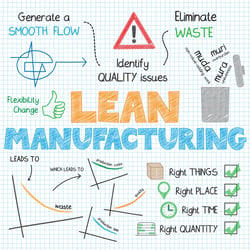October 8, 2015 | Lean
Undeniable Reasons to Love Lean Manufacturing
 Lean manufacturing is a type of manufacturing that uses a play-by-play methodology for eliminating waste which occurs naturally in the manufacturing process. While a typical manufacturing cycle encompasses the product from start to finish, lean manufacturing focuses on cutting out the fat, any non-value work activity. This is done by evaluating the fatty areas that encompass all actions in the manufacturing cycle from office activities through the distribution of products.
Lean manufacturing is a type of manufacturing that uses a play-by-play methodology for eliminating waste which occurs naturally in the manufacturing process. While a typical manufacturing cycle encompasses the product from start to finish, lean manufacturing focuses on cutting out the fat, any non-value work activity. This is done by evaluating the fatty areas that encompass all actions in the manufacturing cycle from office activities through the distribution of products.
Toyota, for example, has employed lean manufacturing from the start and continually improves and eliminates waste where necessary, providing the most efficient production process for them to create well-oiled and balanced automobiles.
What Are “Fatty” Areas of Manufacturing?
If you are in the manufacturing industry, you may have already encountered some “fatty” areas- also known as “Muda,” which is a Japanese term for waste- in the process your organization uses. Conversely, if you are relatively new to the concept of lean manufacturing, you may be thinking, “how can there be fatty areas in what seems like a simple system?”
There are actually 9 identifiable opportunities to remove common fatty areas that most manufacturers encounter. These include:
- Overproduction
- Poor Processing
- Waiting Time
- Inventory
- Transportation
- Motion
- Creativity
- Quality
- Information
Reasons to Love Being Lean
Concept
A fundamental key to going Lean is the understanding that it is a continual improvement; meaning Lean is never complete. Lean manufacturing is ensuring the manufacturing process is increasing in efficiency and creating ongoing benefits for the organization and for the customer by improving:
- Stock turnover
- Efficiency
- Profitability
- Employee morale
- Inventory
- Machine performance
- Delivery
- Supplier relations
Implementation
Cultural change is a must in the implantation of any lean manufacturing system. It begins with commitment from leadership, starting with senior management trickling down to the leaders responsible for implementing the Lean strategy.
There are 5 principles to satisfy when implementing a Lean system:
- Understand value as defined by the customer
- Define the value stream for the organization
- Establish continuous flow within the organization
- Maintain the flow through the use of a pull system
- Pursue perfection through continuous improvement of the processes
Tools
Knowing what parts of your organization are subjects for Lean changes are identified by a trained and experienced individual and sustained by the right tools.
CMTC offers a lean manufacturing toolkit with tool names and descriptions; some tools listed are Kaizen which is a process for continual improvement of events, or Value Stream Mapping, which illustrates current and future states.
Results
Many of us have preconceived notions of what manufacturing is and how it works. Truth be told, there are a variety of manufacturing processes and practices that organizations in the industry implement.
Which process works for your organization is dependent on the size, the product and the structure specific to your organization.
Organizations start to see the benefits of going Lean in a matter of weeks, most within a few months. However, to maintain the benefits of going Lean, it must be a company-wide effort and commitment to the Lean changes.
Any organization incorporating and mastering lean manufacturing concepts has the potential for greater achievement and for a healthier manufacturing cycle. They are making a commitment that increases customer-centric behaviors and improves their global competition, profits and efficiency.

